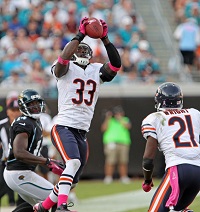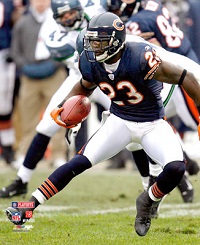[adsenseyu1]
A few weeks ago Jason LaCanfora published a list of best and worst contracts in the NFL so I thought it might make a good idea for us to do the same here at OTC, with a team by team approach. I’ll try to be a bit more analytical in terms of why money was paid and how it fits in the market, but the general premise is the same. The one key difference is outside of restructured rookie contracts under the old CBA we will only use veteran contracts as there is a big difference between best draft picks and best contracts. Please note that there is a difference between a bad player and a bad contract when discussing some of the selections. Clicking on a players name will take you to his salary cap page.
 Best Contract: Charles Tillman
Best Contract: Charles Tillman
Tillman has been one of the better corners in the NFL for the last 4 or 5 years. He is a perfect player for the schemes that the Bears have run in his tenure in Chicago and he has done it all playing on a low cost contract that averages just over $6.1 million a season. The $6.1 million dollar figure has become a steal in an era where cornerbacks began making over $10 million a season. To put it in perspective the year Tillman signed his contract, 2007, was the same year Nate Clements signed a shocking $64 million dollar contract with the 49’ers. Since then Tillman has been to two Pro Bowls while Clements was finally cut once the salary cap allowed in 2011 before heading over to play with the Bengals at a fraction of the cost.
Tillman never compromised the Bears salary cap in all his years in Chicago. The Bears frontloaded the cap charges of the deal, using up cap room, and trying to align his cap dollars with what they felt his performance might be as he got older, except Tillman got better rather than worse. From 2008 thru 2012 the Bears paid less than $5 million a year in cap dollars for what turned out to be a Pro Bowl player. Chicago could have easily escaped the deal in 2011 had he not become a great player.
In 2013 Tillman will make $8 million in both cash and cap. The year was thrown in to simply inflate the total value of the contract. There was no dead money in the season and at the time every report referred to 2013 as a “dummy year”. Now the “dummy year” is here and even at $8 million the Bears have no need to let someone as valuable as Tillman leave. I got the chance to discuss once with someone who worked in the League, among other things, about what is and is not a bad contract and I’ll always remember how he told me that a deal that plays out to the end is pretty much a great deal. And that is exactly what the Bears have with Tillman. A great deal.
 Worst Contract: Devin Hester
Worst Contract: Devin Hester
The Bears don’t have too many really bad deals and I could have gone to a handful of spots with this choice (those who have read all of these likely know how much I want to put Matt Forte down), but the Hester contract was all about buying into a hype machine that never should have existed beyond fans and Sportscenter. Yes Devin Hester is a spectacular punt/kick returner, but there is a big difference between catching a punt and running with it and catching a ball in the middle of the field and doing the same. The Bears assumed that he would catch the ball and be lighting in open space.
All it took was two years for the Bears to convince themselves Hester needed to be a wide receiver. Now they still had him under contact for two seasons where they could have experimented with the idea but rather than doing that they signed him to a 4 year extension averaging close to $5.5 million a year, way overpaying for a punt returner and putting him right in the upper echelon of the tier 2 WR. The Bears even took it a step further giving him opportunities to max the contract out at $8 million a season if he ever developed into a star WR. Why? Only they can tell you, but if you are willing to give an early extension like this usually you want the upside to come cheap. They just gave him a raise with a chance to push it even further.
With Hester being pushed into the full time WR role his return game disappeared. His punt return yards fell below 8 per return. There were no punt or kickoff returns for scores. The Bears wasted two years of his real talent to justify their investment in him as a wide receiver, force feeding the ball as a number 1 target. There was no explosion as a WR and he never developed into the role. Finally they pulled back and let him do more returning and be a third or fourth target in the offense.
In fairness to the Bears the backend of his contract never hurt that badly since they did extend him early allowing money to be frontloaded into the deal preparing the backend for raises due to performance. Hester could have been cut last season with about $1.7 million in dead money. He will likely be battling for a roster spot on the cap strapped Bears, who only have about $1.6 million in space and are reluctant to extend any players for cap relief. Cutting Hester saves the team $1.857 million.
Check out Our Other Best & Worst Contract Articles
AFC East: Buffalo Bills, Miami Dolphins, New England Patriots, New York Jets
AFC North: Baltimore Ravens, Cincinnati Bengals, Cleveland Browns, Pittsburgh Steelers
AFC South: Houston Texans, Indianapolis Colts, Jacksonville Jaguars, Tennessee Titans
AFC West: Denver Broncos, Kansas City Chiefs, Oakland Raiders, San Diego Chargers
NFC East: Dallas Cowboys, New York Giants, Philadelphia Eagles, Washington Redskins
NFC North: Chicago Bears, Detroit Lions (July 18)
[subscribe2]
[adsenseyu2]